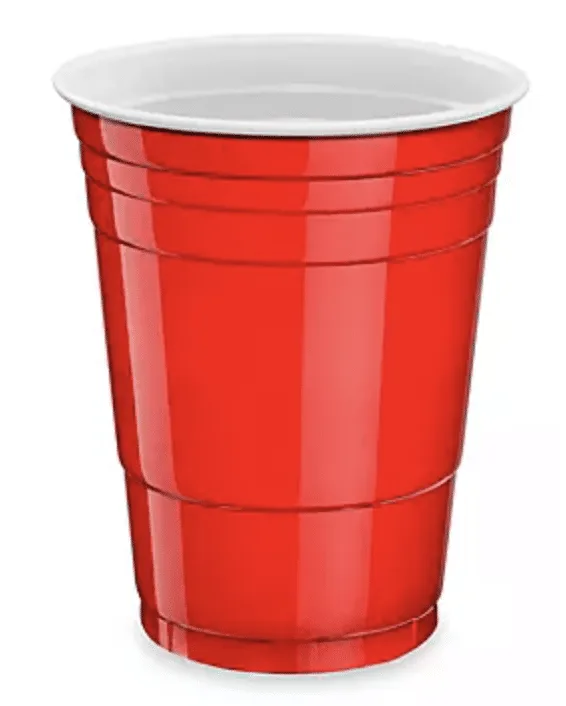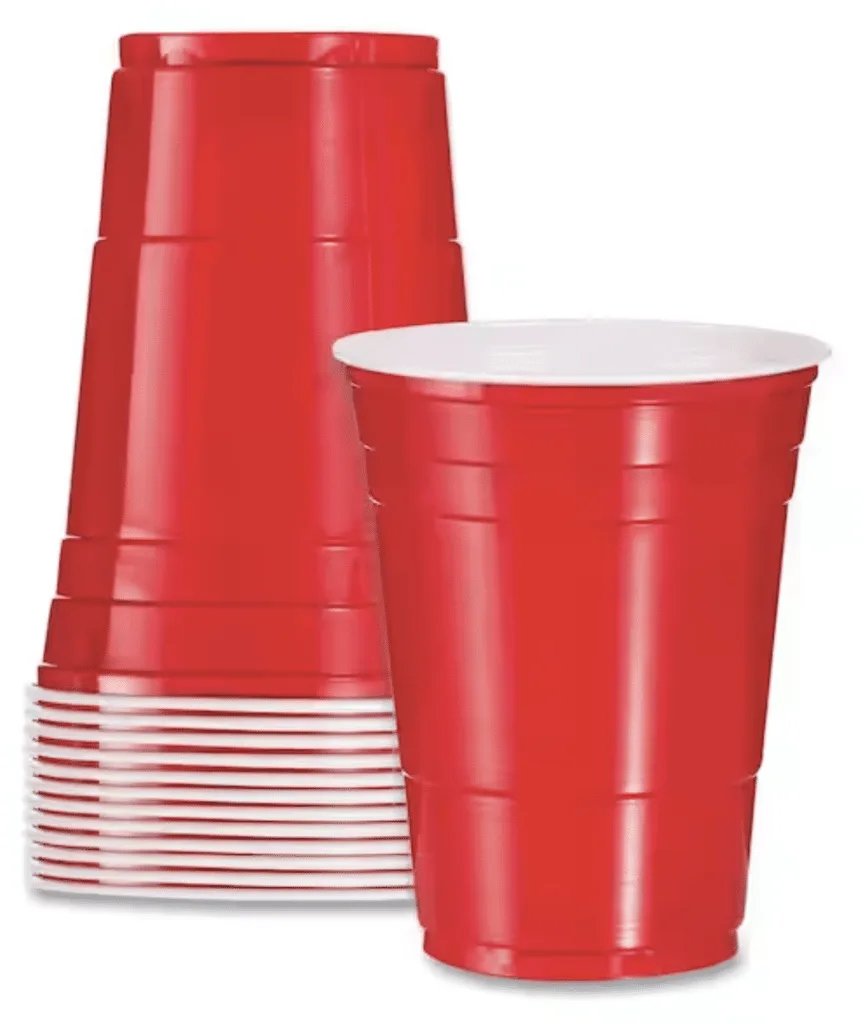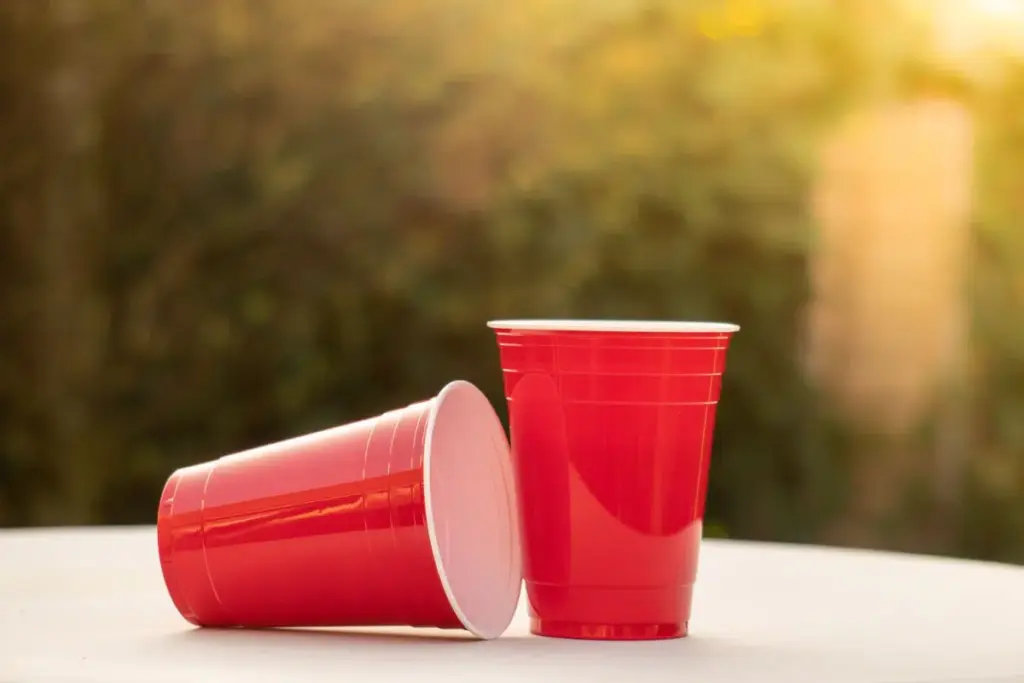Red Solo cups are synonymous with parties, barbecues, and all things summer. They’re cheap, disposable, and hold a surprising amount of your favorite beverage. But have you ever wondered if you can microwave red solo cups?

The short answer is no, you shouldn’t microwave red Solo cups. While it might seem tempting to quickly heat up your coffee or leftovers in a pinch, it’s not safe for several reasons.
What Are Solo Cups?
The red Solo cup. It’s an American cultural icon, instantly recognizable and synonymous with parties, barbecues, and tailgating. But where did these ubiquitous cups come from, and what makes them so special?
From Humble Beginnings to Party Essential
In 1936, Leo Hulseman, a former employee of the Dixie Cup Company, had an idea. He wanted to create a disposable cup that was sanitary and safe for public use. His first invention was a small, paper cone designed for water companies. But it was his 1940s creation, the now-iconic red plastic cup, that truly took off.
The Solo cup’s success can be attributed to several factors. First, it was cheap and disposable, making it ideal for large gatherings and events. Second, its bright red color made it easy to spot in a crowd. And third, its simple, stackable design made it easy to store and transport.
More Than Just a Cup
Over the years, the Solo cup has become more than just a cup. It’s a symbol of American culture, appearing in countless movies, TV shows, and music videos. It’s been used to build pyramids, play beer pong, and even crown sporting event champions.
Today, Solo cups come in a variety of colors and sizes, but the classic red cup remains the most popular. It’s a reminder of simpler times, of backyard barbecues and summer nights spent with friends. It’s a symbol of celebration, of coming together to share good times.
What Happens If You Microwave Solo Cups?
What happens when you microwave Solo cups depends on two main factors: the type of Solo cup and what you’re doing with it. Here’s a breakdown:
Type of Solo Cup:
Paper Solo cups: Solo brand’s paper dinnerware is labeled as microwave safe for limited reheating of food. This means it’s generally okay to warm liquids or food for short periods at moderate temperatures. However, excessive heat can still cause warping, charring, or even fire, so it’s best to err on the side of caution and use caution:
Avoid prolonged heating or high temperatures.
Keep an eye on the cup while it’s in the microwave.
Don’t use Solo cups for cooking or boiling liquids.
Plastic Solo cups: Solo does not manufacture plastic cups, but various plastic cups are often called “Solo cups” generically. Microwaving any plastic cup not explicitly labeled microwave safe is a big no-no! Here’s why:
Plastic can melt, deform, or even release harmful chemicals when heated.
Burns from melted plastic are a serious risk.
Fire outbreaks are also possible with certain types of plastic.
What you’re doing with the cup:
Empty Solo cup: This is the worst-case scenario, especially for plastic cups. The cup can easily melt, deform, or even catch fire due to the concentrated heat without any food or liquid to absorb it.
Solo cup with liquid: The liquid’s presence helps distribute the heat and reduce the risk of melting or fire. However, it’s still crucial to:
Use only microwave-safe cups.
Use short heating times and moderate temperatures.
Watch the cup closely and stop if you notice any warping, bubbling, or other signs of distress.
What Temperature Can Solo Cups Withstand?
Solo cups come in two main varieties: plastic and paper, and their temperature tolerance varies depending on the material and intended use. Here’s a breakdown:
Plastic Solo Cups:
Standard red party cups: These are made from polypropylene (PP) and can withstand temperatures ranging from 32°F (0°C) to 176°F (80°C). So, they’re fine for cold drinks, room temperature beverages, and even hot coffee or tea for a short time. However, exceeding 176°F could cause the cup to warp or melt.
Hot beverage Solo cups: Some Solo cups are specifically designed for hot drinks and may be made from a different plastic like polystyrene (PS). These can typically handle temperatures up to 195°F (90°C) but always check the packaging or manufacturer’s information for specific details.
Be very careful and do not microwave red solo cups.
Paper Solo Cups:
Standard disposable cups: These are typically made from double-walled paper with a polyethylene (PE) coating for leak resistance. They’re best suited for cold drinks and room temperature beverages as they can soften and lose their shape around 140°F (60°C).
Hot beverage Solo cups: Similar to plastic hot cups, Solo offers double-walled paper cups designed for hot beverages. These can handle temperatures up to 185°F (85°C) but again, double-check the packaging or manufacturer’s information.
Solo Cup Safety Tips
Solo cups, while iconic and versatile, do come with some potential safety concerns depending on how they’re used. Here are some tips to consider for different scenarios:
Drinking at parties:
Responsible drinking: Pace yourself and keep track of your consumption. Use the lines on the old-style cups as a guide (1 oz, 5 oz, 12 oz), or invest in reusable cups with marked measurements.
Hydration: Alternate alcoholic drinks with water or non-alcoholic beverages to stay hydrated and avoid dehydration, which can worsen intoxication.
Food: Food helps slow down alcohol absorption. Eat before and during drinking.
Buddy system: Look out for yourself and your friends. If someone seems overly intoxicated, encourage them to switch to water and rest.
Spiking awareness: Be aware of your drink and don’t leave it unattended. If you suspect tampering, discard it and get a new one.
Other uses:
Heat: Solo cups are not microwave-safe and can melt or warp, releasing potentially harmful chemicals. Use them for cold beverages only.
Sun exposure: Leaving Solo cups under direct sunlight for extended periods can leach chemicals into the contents. Keep them shaded for better safety.
Sharp edges: Torn or damaged Solo cups can have sharp edges. Handle them carefully and discard if torn.
Burns: Using Solo cups to hold sparklers or other open flames can melt the plastic and cause serious burns. Use appropriate holders instead.
General safety tips:
Dispose of Solo cups properly: Recycle or compost them according to your local guidelines.
Avoid littering: Solo cups are common litter items. Throw them away responsibly.
Consider reusables: Opt for reusable cups to reduce waste and environmental impact.

What Are the Alternates of a Solo Cup: for Microwave Use
Regular Solo cups are not microwave-safe due to the potential for harmful chemicals leaching into your food or beverage at high temperatures. However, there are plenty of fantastic alternatives you can use in the microwave instead, depending on your needs and preferences. Here are a few options:
Ceramic Mugs
These are classic choices for hot beverages and are generally microwave-safe. They come in a vast variety of sizes, colors, and designs, and they do a great job of retaining heat. Just be sure to check the bottom of the mug for a microwave-safe symbol before using it.
Glass Mugs
Similar to ceramic mugs, glass mugs are microwave-safe and offer excellent heat retention. They’re also great for visual appeal, as you can see the contents of your mug. Look for tempered glass mugs for added durability.
Stainless Steel Mugs
These are a durable and eco-friendly option. They’re perfect for travel and keep your drinks hot or cold for extended periods. However, some stainless steel mugs might not be microwave-safe, so be sure to check the manufacturer’s instructions.
Microwave-Safe Plastic Mugs
There are several brands of plastic mugs specifically designed for microwave use. These are often BPA-free and made from heat-resistant materials. However, keep in mind that plastic mugs generally don’t insulate as well as ceramic or glass, so your beverage might cool down faster.
Silicone Mugs
Collapsible silicone mugs are a great option for portability and storage. They’re also microwave-safe and can withstand high temperatures. Just make sure the silicone is food-grade and BPA-free.
Stoneware Mugs
Stoneware mugs are similar to ceramic mugs but offer a more rustic aesthetic. They’re generally microwave-safe and good at retaining heat. However, they can be heavier than ceramic mugs.
Bonus Tip: If you’re looking for a disposable option, consider using compostable mugs made from plant-based materials. These are a more eco-friendly alternative to traditional plastic cups and can be safely used in the microwave.
Ultimately, the best alternative to a Solo cup for microwave use depends on your individual needs and preferences. Consider factors like durability, heat retention, portability, and environmental impact when making your decision.

Frequently Asked Questions (FAQs)
No, most plastic cups should not be put in the microwave. They can melt or release harmful chemicals when heated. Always check for microwave-safe labels.
No, this is very unsafe.
Yes, you can heat up a red cup, but it depends on the material of the cup. If it’s microwave-safe plastic or ceramic, you can safely heat it.
Yes, it’s okay to reuse red Solo cups, but they should be thoroughly washed between uses. While they are designed for single use, reusing them after proper cleaning can be a more environmentally friendly option. Just be sure they are not cracked or heavily soiled, which could harbor bacteria.
You May Also Like
- Can You Microwave Styrofoam Cups?
- Microwave Coffee in a Styrofoam Cup
- Microwave Cup Noodles
- Can You Microwave Dixie Cups?
- Can You Microwave Paper Cups?
I hope this post about can you microwave red solo cups helped you!
